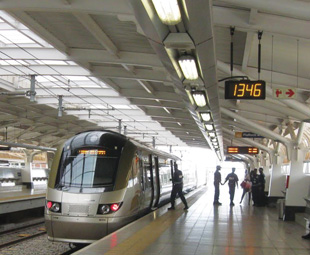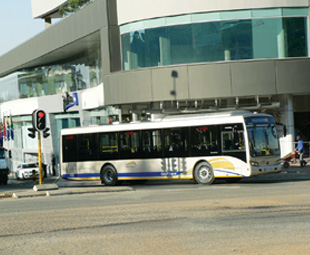Gautrain and bus… counting the pennies

The Gautrain and its bus feeder system will bring a new era in public transport that will not only affect ordinary commuters, but bus, minibus/metered taxi operators, shuttle services, tourism operators, hotels, as well as corporates, who may wish to provide staff transport to and from the stations, writes UDO RYPSTRA.
The big debate whether it will be cheaper to use the Gautrain service between Pretoria and Johannesburg or the Ben Schoeman highway linking the two cities will probably intensify next month when the outcome of the probe into toll fares will be known.
Transport Minister S’bu Ndebele, being interviewed on SABC2’s Morning Live, recently said he expected the results to become available between the end of April and mid-May.
The probe followed the public outcry about the proposed toll tariffs which would have cost motorists 66c per kilometre and multi-axled trucks, truck-trailer combinations and buses a whole lot more. Those with an e-tag (because they would use the route regularly) would receive discounts, however.
Details of the toll fees were gazetted earlier this year. Not only has the South African National Roads Agency Limited (Sanral), which is a division of the Department of Transport, been criticised for the high toll fees, but also for not consulting the road transport industry on the toll fees – details which were revealed about a year ago. Among the critics are the Automobile Association and South Africa’s Road Freight Association (RFA), which launched a petition a year ago against what it called the “exhorbitant” proposed toll fees.
The tariffs have also angered South Africa’s powerful Congress of South African Trade Unions (COSATU), which has threatened to have all union members go on a nationwide strike. The RFA and Agriforum have also commissioned an investigation into the high cost of the freeway improvement project, which found that it was more than 100% higher than those completed in other parts of the world.
The implementation of toll tariffs on Gauteng’s freeways will come on top of rising fuel prices and, as of 1 April, of a 25,9% hike in electricity tariffs by Eskom. Add toll fees to routes that were never tolled previously, and we have a situation that will affect industry, commerce and households severely. The impact on freight costs, food prices and inflation for the man in the street as a whole, is a story on its own.
Many commuters who use the N1 between Roodepoort and the Gillooly’s interchange close to the East Rand, and the Ben Schoeman freeway linking the CBDs of Johannesburg and Pretoria, will have to look at alternatives. So, too, will commuters and traders who fetch and deliver produce from and to City Deep, who use the M2 between Gillooly’s and the Johannesburg CBD. That’s if the Johannesburg City Council carries out its intention to toll the M2 route as well.
The severe congestion on the Ben Schoeman highway linking Pretoria and Johannesburg is at its worst during peak hours. Pretorians can argue until they are blue in the face but it’s mostly them (privileged to live in South Africa’s sunniest city), who clog the freeway and can afford to motor to work in areas where the money is – in Centurion, Midrand, Sandton, Rosebank and Johannesburg.
The fact that the south bound lanes are congested in the morning (when the northbound lanes are relatively easy going) with the reverse happening in the afternoon, suggests Pretorian motorists will either have to cough up extra for the privilege of living in the country’s sunniest city, or move closer to their places of employment. Resorting to using back roads will increase the congestion even more.
However, from 1 July, when the new toll fees should be known, there will be another alternative: the Gautrain with feeder bus systems that will have commuters investigating their transportation needs – particularly with regard to cost, comfort and travelling times. But bus, minibus and metered taxi operators, as well as corporates (who may wish to provide staff transport to and from the stations), shuttle service providers, tourism operators, hoteliers, and schools, just to name a few.
Starting from the north, there will be no fewer than six Gautrain feeder bus services from Hatfield Station, notably from Brooklyn/Waterkloof (the H1bus route), Lynwood (H2), Arcadia (H3), Waverley (H4) and Menlo Park/Menlyn (H5).
Pretoria station will be served by two feeder routes, one serving the inner CBD (P1) and the other the outer CBD up to Bosman Street (P2).
 The new Centurion station will have four Gautrain feeder routes from Techno Park (C1), Rooihuiskraal North (C2), Wierda Park (C3), and Southdowns/Doornkloof (C5).
The new Centurion station will have four Gautrain feeder routes from Techno Park (C1), Rooihuiskraal North (C2), Wierda Park (C3), and Southdowns/Doornkloof (C5).
The new Midrand station will be served by three Gautrain feeder routes from Randjiespark (M1), Noordwyk (M2), and Sunninghill (M3).
The Gautrain service already has four S-denoted bus feeder services into Sandton station from suburbs such as Wendywood (S2), Rivonia (S3), Randburg (S4) and Sunninghill (S5).
On the way to the airport, Marlboro is the only station not served by feeder buses, but Rhodesfield has one feeder service (R1) going through into Allan Grove and Aston Manor.
The new Rosebank station will be fed by four Gautrain bus routes which will link up with Highlands North/Saxonwold (RB1), Winston Ridge (RB2), Illovo (RB3) and Craighall/Jan Smuts Avenue (RB4).
Last, but not least, there will be a Gautrain feeder bus service from the city’s CBD, where the Rea Vaya and Metrobus terminals are, into Johannesburg’s Gautrain Park station. Close perusal of the feeder bus maps on the Gautrain website, which is very informative and superbly constructed, will show us how easy it will be to get to a sports stadium such as Soccer City, a conference/exhibition venue such as the Pretoria Showgrounds, the CSIR centre near Lynwood, Gallagher Estate in Midrand or the Rand Show at Nasrec.
In addition, these bus feeder services provide access to big shopping malls such as Sandton City or entertainment zones such as the Rosebank Zone, those popular spots along Rivonia Road, or the jazzy Newtown precinct in Johannesburg.
In some cases it may also be necessary to connect with a Metrorail system, a metropolitan BRT system, a shuttle service or, for the poor, the old trusted – but unscheduled, if not dangerous – minibus taxi services.
The only problem I and many other people have with the Gautrain and bus feeder systems is that they stop operating at 9 pm and 9.30 pm respectively. The feeder bus services don’t even operate over weekends.
Commuters using the Gautrain system on a one-off occasion or on a regular basis will now be able to calculate how much it will cost to make use of the Gautrain and its bus feeder services and compare it with the cost of travelling by car or an other modes of transport (see our case study on page 75).
To get to the airport from the new stations will cost varying amounts. For example, the trips between OR Tambo International and Park Station, Rosebank and Midrand will set travellers back R115, while the journey between Centurion, Pretoria, Hatfield and the airport will cost R125. “Nobody else can offer you a trip like this,” said the chief executive officer of the Gautrain Management Agency, Jack van der Merwe, when the fares were announced. “There is no need to worry about traffic cops, accidents, and we are working with 99 per cent predictability and reliability.”
Single fares (pay as you go) between all the stations except the Ortia terminal vary between R19 (Hatfield-Pretoria) and R49 (Hatfield-Park Station) It’s R20 if you use any feeder bus between two bus stops on a bus route, say from Rosebank Station to the Wanderers where the RB3 bus service will take you, but less if you travel by bus within a certain time of boarding or disembarking the train.
The Gautrain website provides all the details, the discounts and even parking fee tariffs for those who want to leave their cars at a station during working hours. The saver pass is the weekly option, which comprises ten trips between two pre-chosen stations. Weekly ticket holders will pay R44 per trip, or 10% less, between Hatfield and Park Stations. Commuters will need to start using the pass within seven days of purchase, and it will expire seven days after its first use, regardless of whether all 10 trips have been used.
The super-saver pass refers to the monthly ticket, which caters for 44 single trips between two pre-chosen stations and monthly ticket holders will pay R39, or 20% less. Travellers will also have to use the pass within seven days of purchase, and it will expire 35 days after first use, again regardless of whether all trips have been taken.
As well as unveiling the new fares, the Gautrain Management Agency also said the prices for the airport service would be increasing from 1 June, from R100 to R105 for the current stops. “The determined fares are based on the principle of affordability and are highly competitive compared to other modes of public transport,” said the Gauteng MEC for roads and transport, Ismail Vadi. “They are sufficiently price-attractive to create a substantial shift from private car use to public transport in the form of the Gautrain.”
Published by
Focus on Transport
focusmagsa




